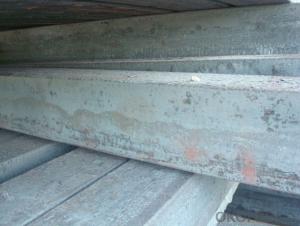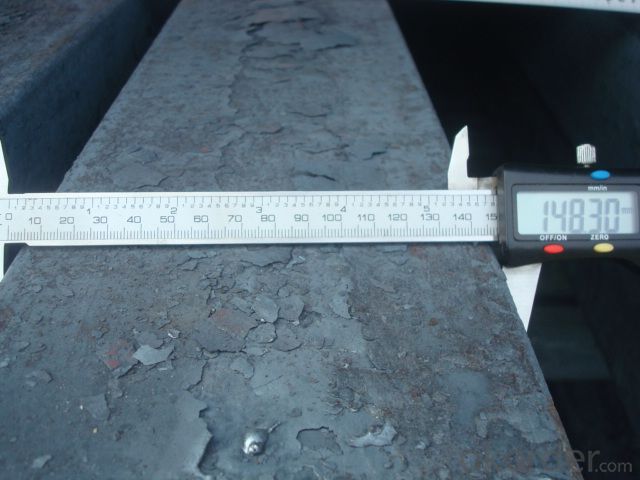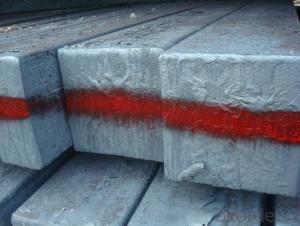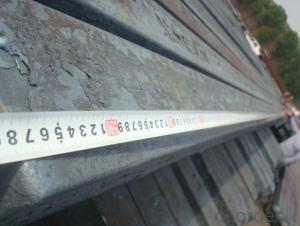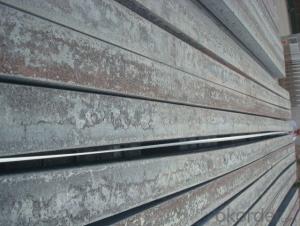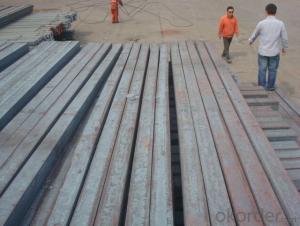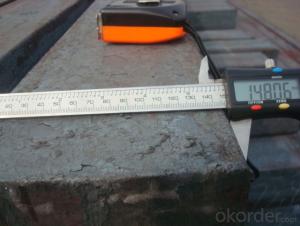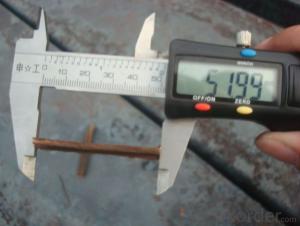Alloyed Steel Billet/Bloom by Continue Casting Blast Furnace
- Loading Port:
- Tianjin
- Payment Terms:
- TT OR LC
- Min Order Qty:
- 1000 m.t.
- Supply Capability:
- 10000 m.t./month
OKorder Service Pledge
OKorder Financial Service
You Might Also Like
Alloyed Steel Billet/Bloom by Continue Casting Blast Furnace
1.Structure of Alloyed Steel Billet/Bloom by Continue Casting Blast Furnace
Continue Casting Steel Billet Manufactured By Blasting Furnace is the raw material of all kinds of steel mill. Billet section of square, round, flat, rectangular and abnormity, etc Several, mainly related to shape of rolled products. Simple rolled section steel, choose cross section of square billet or rectangular billet. rolling The sector products such as flat steel, Angle steel, select the rectangular billet or slab. Had better profiled billet when production beams, channels, and in rolling process Lines and improve the yield. The raw material of round billet is the production of seamless tube.
2.Main Features of Alloyed Steel Billet/Bloom by Continue Casting Blast Furnace.
Continue Casting Steel Billet Manufactured By Blasting Furnace section size should meet the requirements of rolling deformation and finished product quality, but also roll strength and biting condition of restrictions. General steel Billet section height H. And the roll diameter D The ratio of the ( namely H/D) Should be less than or equal to zero 0.5 . Length of steel billet by finishing temperature, Rolling time and the length of the product Or times ruler. When heated too long accident prone to bump the furnace wall of steel, too short, furnace bottom utilization rate is not high, influence the heating furnace production. For the production Choose a variety of steel and steel billet, should consider the affinities of billet, as far as possible in order to improve the productivity of the roughing mill, simplify the stock management of workshop.
There are three shapes of the steel billets: square billet, slab, rectangular billet The Chinese billet, rectangular billet is mainly suitable for rolling hot rolled strip, building reinforced bar, Ordinary wire, high speed wire rod and various small profile. Of the slab are mainly used for rolling plate and hot coil sheet.
3. Alloyed Steel Billet/Bloom by Continue Casting Blast Furnace Images
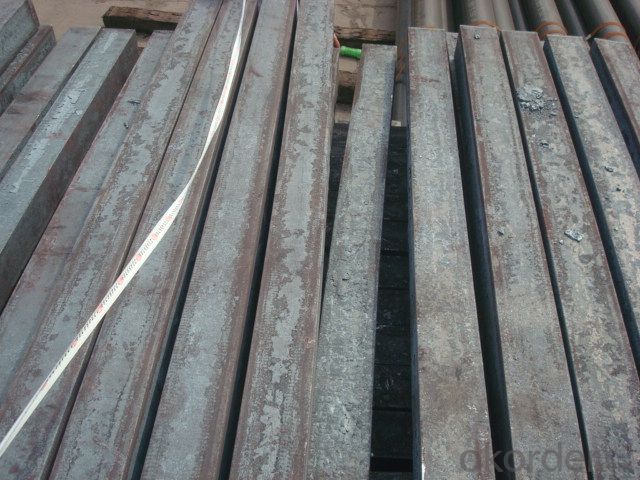
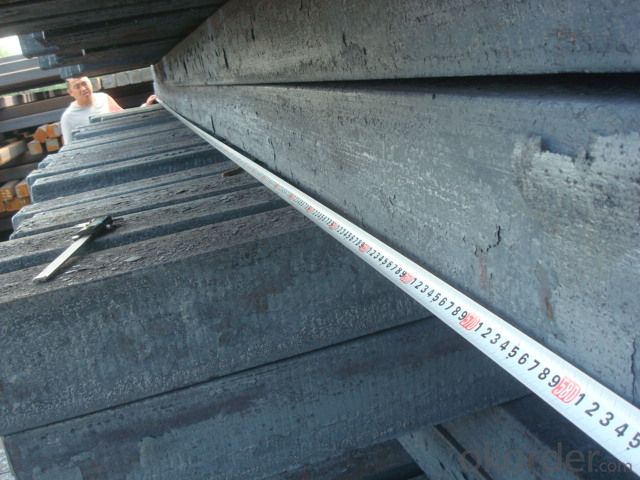
4. Alloyed Steel Billet/Bloom by Continue Casting Blast Furnace Specification
Continue Casting Steel Billet Manufactured By Blasting Furnace rolled steel, after processing can be used for mechanical parts, forging parts, processing all kinds of steel, steel Q345B channel steel, wire rod is the role of the billet. Steel billet is used in the production of semi-finished products, generally cannot be used directly for the society. Steel billets and steel are strictly divided into standard, cannot decide to whether the business enterprise of the final product, and according to unified standards to perform the whole society. Typically, billet and the steel is relatively easy to distinguish, but for some steel billet, and have the same specification and same steel purposes (such as rolling tube billet), whether can be used for other industries, whether through steel processing process, whether through a finished product rolling mill processing to distinguish
Material standard The editor Range of thickness: 150-240 - mm + / - 5 mm width range: 880-1530 - mm + / - 20 mm Length: 3700-10000 - mm + / - 500 - mm Cross-sectional size: 64 * 64; 82 * 82; 98 * 98; 124 * 124; 120 * 150; 152 * 164; 152 * 170 mm Length: 9000 mm Section of tolerance: billet: 1.0 + / - 2.0-1.0 + / - 1.0 mm slab: width: + / - 2.0 mm thickness: + / - 3.0 mm The length tolerance: + / - 200 mm Section diagonal tolerance: 3.5-8.0 MM Billet section size protrusions requirements: < 1242 mm, do not allow; > = 1242 mm, < = 2 mm 1242 mm, < = 3 mm Beheading (shear) extension deformation: < 1242 mm billet: no control; The slab: < = 15 mm Surface tilt: no more than billet section 0.1 Bending: every 1 m length is not more than 10 mm The distortion: length < = 5 m, < = 11. ; The length of the < = 7.5 M, < = 5. Material % 3 sp/PS chemical composition: C Mn Si S P
5.FAQ of Alloyed Steel Billet/Bloom by Continue Casting Blast Furnace
We have organized several common questions for our clients,may help you sincerely:
①What kinds of the steel billet you have?
We usually export the Q195/215/235/275, size: 120*120/130*130/150*150*12000/6000mm steel billet to our customers..
②Could we get the third party quality inspecting report?
Sure, but the inspecting fee belong to our customers payment in advanced.
③What quality problem we could claim?
Any problem not meet the contract you can tell us and we will be respansible for you.
For example:The defect of billet according to its source can be divided into two categories:Lack of steelmaking and castingAnd the rolling defects caused by.From the defect of the parts and can be divided into two kinds of surface defects and internal defects.The main steel billet defectsThere should be: scar, crack, cracking and inclusions(See the non-metallic inclusions), shrinkage residual(See the shrinkage cavity), airbag, air bubble, insideCrack, burnt, internal heat, tail hole, teeth marks, folding, scratches, indentation, sag, Angle, bending(See the bending),Handle defects, torsion, crack, shear, mesh, cleaning up bad, skull patch, seam crack, split, out-of-tolerance and sizePitting, etc.
1)Airbags.Boiling steel billet shearing area appear similar to the defects of shrinkage cavity.Section on the vertical axis of symmetry of the tongueWave, wave gap in granular inclusions, blaze, discoloration, etc.Sometimes the surface of the bulge, tearing, shearing widthSuch as large surface phenomenon, finished product billet surface convex hull, cross section on the tongue shape wave, serious billet through a long hole.
- Q: What are the different surface treatments for improved surface lubrication in steel billets?
- Some of the different surface treatments for improved surface lubrication in steel billets include hot rolling, cold rolling, pickling, and applying a lubricant coating.
- Q: How has the demand for steel billets changed over time?
- The demand for steel billets has changed over time due to various factors, including economic conditions, infrastructure development, and technological advancements. In recent years, the demand for steel billets has generally been on the rise as countries invest in construction projects, manufacturing, and automotive industries. However, there have been fluctuations in demand based on global economic trends, such as the impact of the COVID-19 pandemic. Overall, the demand for steel billets has evolved to meet the changing needs of industries and remains an essential component in various sectors.
- Q: Can steel billets be used in the production of construction machinery?
- Yes, steel billets can be used in the production of construction machinery. Steel billets are semi-finished steel products that can be further processed into various shapes and sizes, including the components used in construction machinery. These billets can be hot-rolled or cold-rolled to form different types of steel products, such as bars, rods, plates, or sheets, which are commonly used in the construction industry. The high strength and durability of steel make it an ideal material for construction machinery as it can withstand heavy loads, resist corrosion, and provide structural integrity. Therefore, steel billets serve as a crucial raw material in the manufacturing process of construction machinery.
- Q: How is the market for steel billets influenced by global economic trends?
- Global economic trends have a significant impact on the market for steel billets. Steel is a crucial raw material for industries like construction, automotive, and manufacturing, so any changes in the global economy can greatly affect the demand and pricing of steel billets. During periods of economic growth, there is typically an increased demand for steel products, including steel billets. This is because there are more construction projects and infrastructure development happening during these times. The demand is driven by increased consumer spending, urbanization, and government investments in infrastructure. Therefore, factors like GDP growth, industrial production, and construction activity are vital in determining the demand for steel billets. On the other hand, during economic downturns or recessions, the demand for steel billets tends to decrease. This is due to reduced consumer spending, fewer construction projects, and a slowdown in manufacturing. Global economic indicators, such as GDP contraction, industrial output decline, and reduced infrastructure investment, can negatively impact the market for steel billets. In addition to economic trends, global trade policies and tensions also influence the market for steel billets. Tariffs, quotas, and trade disputes between countries can disrupt the supply chain of steel billets, leading to price volatility and market uncertainty. Measures to protect domestic industries or restrictions on steel imports can limit the availability of steel billets in certain regions, affecting market dynamics and pricing. Currency exchange rates also play a role in the steel billet market. Fluctuations in currency values can affect the competitiveness of steel billet exports and imports. A strong domestic currency may make exports more expensive, reducing foreign demand for steel billets. Conversely, a weak currency may make imports more expensive, potentially increasing demand for domestically produced steel billets. In conclusion, the market for steel billets is closely tied to global economic trends. Economic growth, industrial production, construction activity, trade policies, and currency exchange rates all impact the demand, supply, and pricing of steel billets. Understanding and monitoring these global economic trends is essential for stakeholders in the steel industry to make informed decisions and navigate market fluctuations effectively.
- Q: How are steel billets used in the manufacturing of automotive chassis?
- Steel billets are an integral component in the manufacturing of automotive chassis due to their strength and durability. A steel billet is a semi-finished product that is obtained through the process of casting molten steel into a rectangular shape. These billets serve as the raw material for the fabrication of various automotive components, including chassis. The automotive chassis is the structural framework that supports the weight of the vehicle and provides stability and strength. It is responsible for bearing the load and impacts encountered during driving. Steel billets are used to create the main frame of the chassis, which forms the backbone of the vehicle. The steel billets are first heated and then passed through a series of rolling mills to shape them into the desired form, such as I-beams or C-channels, depending on the specific design requirements. This process helps to increase the strength and rigidity of the billets, making them suitable for the demanding conditions encountered by the chassis. Once the steel billets are formed into the desired shape, they are then welded together to create the chassis structure. The joints are carefully welded using various techniques like arc welding or laser welding to ensure a solid and reliable connection. This welding process ensures that the chassis can withstand the stresses and forces experienced during operation, such as acceleration, braking, and cornering. The use of steel billets in the manufacturing of automotive chassis offers several advantages. Steel is known for its high tensile strength, which allows it to withstand heavy loads and impacts without deforming or failing. It also has excellent fatigue resistance, ensuring that the chassis can withstand repeated stress cycles without compromising its structural integrity. Moreover, steel is readily available, cost-effective, and easily recyclable, making it a preferred choice for automotive manufacturers. It also provides excellent corrosion resistance, which is crucial for vehicles exposed to various weather conditions and road environments. In conclusion, steel billets play a crucial role in the manufacturing of automotive chassis by providing the necessary strength and durability. They are shaped and welded to form the main frame, which supports the weight and provides stability to the vehicle. The use of steel billets ensures that the chassis can withstand the demanding conditions of driving, ensuring the safety and performance of the vehicle.
- Q: What is the typical weight of a steel billet?
- The typical weight of a steel billet can vary depending on its size and purpose. However, a common weight range for steel billets is between 1,000 and 5,000 pounds (450 to 2,270 kilograms). This range allows for flexibility in manufacturing processes and various applications in industries such as construction, automotive, and manufacturing. It is important to note that specific weight requirements may vary depending on the intended use and specifications of the steel billet.
- Q: What is the size range of steel billets?
- The size of steel billets can vary depending on the industry or application's specific requirements. Square or rectangular shapes are usually used to produce steel billets, with dimensions ranging from 100mm to 200mm in width and height. Additionally, the lengths can range from 3 to 12 meters. These dimensions can be customized according to the intended use of the billets, whether it be for forging, rolling, or further processing into finished steel products.
- Q: How do steel billets contribute to the manufacturing of sports equipment?
- Steel billets contribute to the manufacturing of sports equipment by providing a strong and durable material for various components. These billets are often used to create the frames, shafts, and other structural parts of sports equipment such as golf clubs, tennis rackets, and bicycles. The high strength and resilience of steel make it ideal for handling the rigorous demands of sports activities, ensuring that the equipment can withstand impact, vibrations, and repetitive use. Additionally, steel billets can be easily shaped and molded into different forms, allowing manufacturers to create customized designs that enhance performance and optimize weight distribution.
- Q: What are the different surface treatments for improved surface hardness in steel billets?
- There are several different surface treatments that can be used to improve the surface hardness of steel billets. These treatments are designed to enhance the wear resistance and durability of the steel, making it suitable for various industrial applications. One common surface treatment method is through carburizing. Carburizing involves introducing carbon into the surface of the steel billet by heating it in a carbon-rich atmosphere, such as methane or propane. This process forms a hard layer of high-carbon steel on the surface, known as a case, which significantly increases the surface hardness of the billet. Another surface treatment technique is nitriding. Nitriding is a process that involves exposing the steel billet to a nitrogen-rich atmosphere at elevated temperatures. This causes nitrogen atoms to diffuse into the surface of the steel, forming a hard nitride layer. Nitriding not only improves surface hardness but also enhances the resistance to wear and corrosion. A third surface treatment method is induction hardening. Induction hardening utilizes the principle of electromagnetic induction to heat the surface of the steel billet rapidly. Once the desired temperature is reached, the billet is quenched, resulting in a hardened surface layer. This treatment is particularly effective for localized hardening of specific areas on the steel billet. Additionally, shot peening is another surface treatment technique used to improve surface hardness. Shot peening involves bombarding the surface of the steel billet with small, high-velocity steel shots. This process induces compressive stresses in the surface layer, thereby increasing the hardness and fatigue resistance of the billet. Each of these surface treatments has its advantages and disadvantages, and the choice of treatment method depends on the specific requirements and intended use of the steel billets. By selecting an appropriate surface treatment, manufacturers can ensure that steel billets possess the necessary hardness and durability for their intended applications.
- Q: Can steel billets be used for artistic purposes?
- Yes, steel billets can certainly be used for artistic purposes. While steel billets are typically used as raw material in industrial applications such as construction or manufacturing, they can also be transformed into beautiful works of art. Artists often use steel billets to create sculptures, decorative pieces, or even functional objects like furniture. The versatility of steel allows artists to mold and shape it into various forms, while its strength and durability ensure the longevity of the artwork. Moreover, the metallic appearance of steel can add a modern and industrial aesthetic to artistic creations. Overall, steel billets offer artists a unique medium to express their creativity and create visually stunning pieces.
Send your message to us
Alloyed Steel Billet/Bloom by Continue Casting Blast Furnace
- Loading Port:
- Tianjin
- Payment Terms:
- TT OR LC
- Min Order Qty:
- 1000 m.t.
- Supply Capability:
- 10000 m.t./month
OKorder Service Pledge
OKorder Financial Service
Similar products
Hot products
Hot Searches
Related keywords
